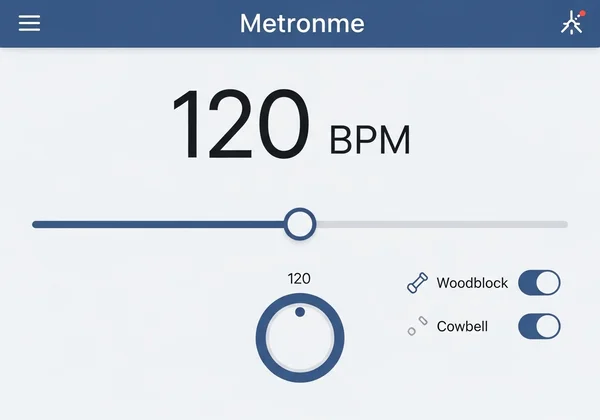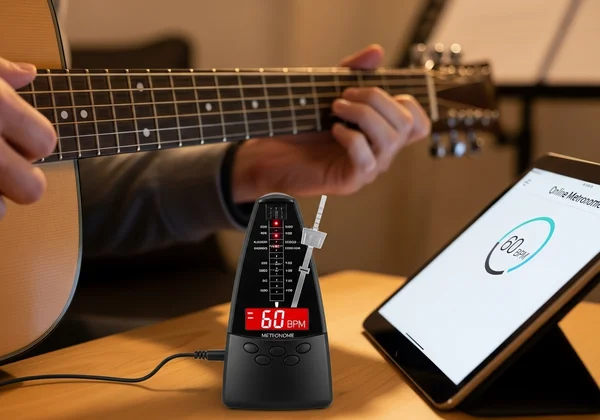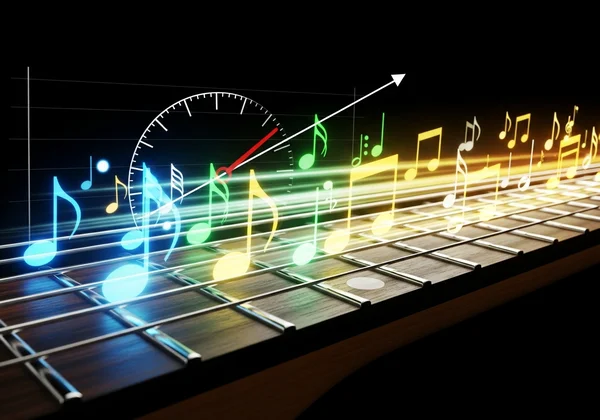Metronome for Guitar: Master Rhythm & Timing Online
Struggling with guitar timing? Inconsistent strumming, rushed solos, or sloppy chord changes can hold you back. A metronome is your most powerful practice tool, offering the precision you need to transform frustrating sessions into rewarding progress. This guide will show you how to use a metronome for guitar to build a rock-solid rhythmic foundation and truly unlock unparalleled precision in your playing.
Setting Up Your Online Guitar Metronome Practice
Before you can fix your timing, you need the right tool and a basic understanding of its functions. A physical metronome can be clunky and limited. An online guitar metronome offers flexibility, advanced features, and is always available on any device, making it a powerful choice for today's guitarist.
Choosing the Right Online Metronome for Guitarists
When looking for the right online metronome, you need three things: accuracy, customizability, and ease of use. A cluttered interface or limited options can hinder your practice. That's why this online metronome tool is designed to be the perfect practice partner. It is a completely free, browser-based tool, meaning there's nothing to download or install.
The interface is clean and professional, allowing you to quickly set your desired tempo. You can choose from various sounds (like woodblock, cowbell, or snare) to find a click that cuts through your guitar's sound without being distracting. This level of control ensures focused, effective practice from the very first beat.

Understanding BPM & Time Signatures for Guitar Practice
Two terms you'll constantly encounter are BPM and Time Signature. Understanding BPM for guitar is your first step. BPM stands for "Beats Per Minute," and it's simply a measure of tempo. A setting of 60 BPM means you will hear 60 clicks in one minute—one click per second. A setting of 120 BPM is twice as fast, with two clicks per second.
A time signature tells you how many beats are in each measure. Most songs you'll play on guitar are in 4/4 time, meaning there are four beats per measure. Other common signatures include 3/4 (think of a waltz) or 6/8. On a quality time signature metronome, you can easily set both the BPM and the time signature to match the music you're practicing.
Essential Guitar Rhythm Exercises with a Metronome
With your setup ready, it’s time to integrate the metronome into your routine with some fundamental guitar rhythm exercises. The goal here is not speed, but perfect timing. Start slow, and only increase the tempo when you can play the exercise flawlessly.
Mastering Strumming Patterns & Chord Changes
Sloppy chord changes are often a result of uneven timing. To fix this, you need to practice strumming patterns with a metronome.
-
Set the Tempo: Start with a slow tempo on the free metronome online, like 60 BPM.
-
Single Strums: Choose a simple C chord. Strum down once on every single click. Ensure your pick hits the strings at the exact moment of the click. Do this for at least a minute.
-
Introduce Chord Changes: Now, switch between a G chord and a C chord. Play the G chord on beat 1 and hold it for four beats. On beat 1 of the next measure, switch cleanly to the C chord. The metronome will instantly reveal if you are late with your changes.
-
Add Strumming: Once comfortable, use a simple down-up strumming pattern, playing a downstroke on the beat and an upstroke between the beats. The click should always align with your downstroke.

Precision in Fingerpicking & Arpeggios
For styles that require intricate fingerwork, fingerpicking with a metronome is non-negotiable. It trains each of your fingers to move with rhythmic independence and accuracy. An arpeggio, which is playing the notes of a chord one by one, demands perfect note spacing.
Start with a simple C major arpeggio. Set your metronome to a slow tempo, perhaps 70 BPM. Assign one note of the arpeggio to each click. Your goal is to make each note sound clean, clear, and perfectly timed with the beat. As you gain confidence, you can play eighth notes, picking two notes for every click of the metronome. This simple exercise builds immense control.
Advanced Metronome Techniques for Guitar Timing Practice
Once you've mastered the basics, you can use more advanced techniques to push your skills further. This is where your guitar timing practice transforms from simple repetition into deep, internalized rhythmic understanding.
Improving Scale & Soloing Speed with a Metronome
Every guitarist wants to increase soloing speed, but playing fast is a byproduct of playing accurately. The metronome is your best friend for building clean, controlled speed.
Use the gradual tempo increase method. Start by playing a major scale at a tempo where you can play it perfectly, for example, 80 BPM. Play the scale up and down flawlessly five times in a row. Then, increase the tempo on the BPM tool by 2-4 BPM and repeat. If you make a mistake, drop the tempo back down. This methodical process builds muscle memory correctly, ensuring your speed is built on a foundation of precision.

Utilizing Tap Tempo for Song Analysis & Practice
Ever heard a song and wanted to play along, but couldn't figure out the tempo? Using Tap Tempo is incredibly useful. Our online metronome includes a powerful "Tap Tempo" feature that lets you instantly find a song's BPM.
Simply listen to the track and tap the button in time with the drummer's snare or the song's main pulse. After a few taps, the tool will display the song's exact BPM. You can then set the metronome to that speed and practice the riffs and chords with perfect accuracy, making learning new songs faster and more efficient. Try our free tool today and see for yourself.
The Silent Practice Mode: Developing Your Internal Clock
The ultimate goal is to develop internal clock so solid that you don't need a metronome. A powerful exercise for this is using silent measures. Set the metronome to play for one measure and then be silent for the next.
Your task is to continue counting and playing through the silent measure and come back in perfectly on beat one when the click returns. This is challenging, but it's the single best way to test if you've truly internalized the rhythm. It forces you to feel the pulse internally rather than just reacting to an external click.

Avoiding Common Metronome Mistakes in Guitar Practice
Using a metronome is simple, but there are pitfalls that can slow your progress. Avoiding these common metronome mistakes will ensure your practice time is as productive as possible.
Don't Start Too Fast: The Gradual Tempo Increase Method
The most common mistake is impatience. Many players jump to a high tempo, thinking it will make them learn faster. This only builds bad habits and sloppy technique. Remember the key principle: "Slow is smooth, and smooth is fast."
Apply the gradual tempo increase method described earlier. Starting slow allows your brain and muscles to build a perfect connection. Speed will come naturally as a result of that flawless foundation. Trust this methodical approach, and precision will follow naturally.
Beyond the Click: Cultivating Your Inner Pulse
Don't treat the metronome as your enemy or a rigid overlord. Think of it as your drummer—a perfectly steady bandmate. The goal isn't just to play "at the same time" as the click; it's to lock in and groove with it.
To cultivate inner pulse, try to feel the space between the clicks. Anticipate the beat rather than waiting for it. When you shift your mindset from following the click to playing with the click, your playing will feel more musical and less robotic.
Revolutionize Your Guitar Practice Today with an Online Metronome
From cleaning up your chord changes to building blistering solo speeds, the metronome is the most crucial tool in a guitarist's arsenal. It provides honest feedback, builds discipline, and is the key to unlocking a professional level of timing and rhythm. By integrating these exercises and techniques into your daily routine, you will see a dramatic improvement in your playing.
Stop letting inconsistent rhythm hold you back. An accurate, customizable, and free online metronome is waiting to transform your practice sessions. Start your journey towards rhythmic mastery today!
Frequently Asked Questions About Metronomes for Guitarists
What is a good BPM for guitar practice?
A good BPM depends entirely on the goal. For learning a new, complex passage or focusing on chord change mechanics, a very slow tempo of 60-80 BPM is ideal. For general rhythm practice and strumming, 80-120 BPM is a common range. When building speed, you should start at a comfortable tempo and gradually increase it.
How can a metronome improve my guitar rhythm and timing?
A metronome provides an objective, unwavering pulse that acts as a mirror for your playing. It immediately exposes whether you are rushing, dragging, or playing unevenly. Consistent practice with this feedback builds a strong internal clock, leading to tighter strumming, cleaner solos, and an overall more professional and confident sound.
Is an online metronome as effective as a physical one for guitar practice?
Yes, and in many ways, it's superior. A high-quality online metronome offers the same precision as a physical device but with far more flexibility. It's accessible on any device, requires no batteries, and often includes advanced features like customizable time signatures, various sound choices, and the incredibly useful Tap Tempo function, all for free.
How do I use 'Tap Tempo' to find a song's rhythm on my guitar?
It's incredibly simple. First, listen to the song and identify its core beat—usually the kick and snare drum. Then, visit our homepage and find the 'Tap Tempo' button. As you listen to the song, tap the button in time with the beat. After just a few seconds, the tool will calculate and display the song's exact BPM, which you can then use to set the metronome for your practice.